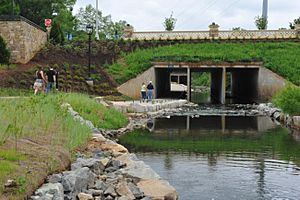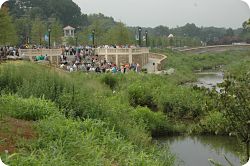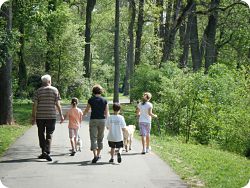Little Sugar Creek Greenway facts for kids
Quick facts for kids Little Sugar Creek Greenway |
|
|---|---|

Looking south at E 4th Street overpass
|
|
| Type | Greenway |
| Location | Charlotte, North Carolina |
| Operated by | Mecklenburg County Parks and Recreation |
| Website | Little Sugar Creek Greenway |
The Little Sugar Creek Greenway is a special kind of park in Mecklenburg County, North Carolina. It's a long, narrow park that follows a stream. When it's all finished, it will have twenty miles of trails and paved paths. These paths will stretch from Cordelia Park in north Charlotte, through the middle of the city, and all the way to the South Carolina border.
This greenway is an important part of the Carolina Thread Trail. This larger network of trails will connect 15 counties in the region.
Greenways are designed to be good for both people and nature. They are narrow strips of land with plants and trees. They offer places for people to walk, bike, and enjoy the outdoors. Greenways along streams, like Little Sugar Creek, also help keep the water clean. They can even help control flooding. Mecklenburg County has about 37 miles of developed greenways, and Little Sugar Creek is one of them.
Two main parts of the Little Sugar Creek Greenway are in the city. They create five miles of paved path. This path goes from East 7th Street south to Brandywine Road.
Contents
The Story of Little Sugar Creek Greenway
Little Sugar Creek's Past
Unlike many big cities, Charlotte isn't built next to a large ocean, lake, or river. Instead, it has many small streams and creeks. Little Sugar Creek is one of the most well-known. Its name comes from the Sugaree tribe, who lived in this area long ago.
Over time, as Charlotte grew, parts of Little Sugar Creek became hidden. Houses, factories, and roads were built over it. The stream also became very dirty from pollution and trash.
Around the year 2000, Little Sugar Creek was known as the most polluted stream in the area. Businesses used to dump waste directly into it. The bad smells were so strong they could damage paint on nearby buildings. Also, buildings in areas that flooded often had to be torn down. Much of the stream was covered with concrete, which later had to be removed. The pollution started to get better when dumping waste directly into the stream was stopped in 1998. Even with these efforts, cleaning up Little Sugar Creek became the most expensive stream cleanup project in Mecklenburg County.
Creating the Greenway
The idea for a "Charlotte waterfront" on Sugar Creek began in 1968. A city council member named Jerry Tuttle was inspired by San Antonio's River Walk. In 1974, the Mecklenburg County Park and Recreation Commission started looking into building a greenway system. A big plan was made in 1980 for 20 creeks and streams.
The idea of a full greenway system was also supported by county commissioner Tom Ray. He came up with a plan called "Sugar Creek Projection 70."
Charlotte's city center started growing, which was different from other cities losing people to the suburbs. This growth made it even more important to save green spaces in the city. So, the Mecklenburg County Parks and Recreation Department decided to update their greenway plans. They wanted to make new greenway paths and improve the ones already there.
Finally, in 1999, a special bond plan was approved. This money was used to buy land along the stream. It also helped start building paved walkways and restoring wetlands. They also built water gardens and began the big stream cleanup project. The part of the Little Sugar Creek Greenway in the city cost $43 million.
Even though the main plan was set, not much happened until 2000. That's when a 10-year growth plan was created. The North Carolina Department of Transportation announced that the Charlotte part of the greenway was finished on April 24, 2012.
Sections of the Greenway
The Little Sugar Creek Greenway is divided into four main parts. These sections go from north to south.
- Cordelia Park to 12th Street
- This paved path is almost one mile long (.95 miles). It follows Little Sugar Creek from Cordelia Park to Greenway Crescent Lane and East 12th Street. This part is near Alexander Street Park. You might see Gulf Coast spiny softshell turtles in the creek here. This section doesn't connect to the rest of the greenway yet.
- East 7th Street to Morehead Street
- This is the "urban section" of the greenway. It is 1.29 miles long and runs through uptown Charlotte. It was finished in April 2012. It starts at 7th Street and goes past Central Piedmont Community College. It also goes through Thompson Park and connects to Midtown Park. This section ends at the Morehead Street underpass. It's the most developed part of the greenway. It has paved paths, stone walls, fountains, and places to eat. There are also many new trees, large rocks, gardens, and statues. A clock tower is also here. You'll find overpasses and underpasses so you can walk and bike without stopping. It also has benches, bike racks, restrooms, and a snack stand.
- Morehead Street to Brandywine Road
- This section connects to the urban part through the Morehead Street underpass. The first part is called the Liz Hair Nature Walk. It's a straight path along Sugar Creek. It was finished in September 2005. This part is .65 miles long and goes from Morehead Street to East Boulevard. It's next to the Carolinas Medical Center. The next part goes from East Boulevard to Princeton Avenue. It passes by the Charlotte Nature Museum and through Freedom Park. Then there's a short part that uses existing sidewalks on Jameston Drive. The paved greenway starts again at Hillside Avenue. It continues to Brandywine Road, ending behind the Park Road Shopping Center. This last section has special ponds that help filter water. It also has signs that explain things.
- Huntingtowne Farms Park Section
- This is the southernmost part of the greenway that is currently open. It is .79 miles long. Most of it is inside Huntingtowne Farms Park. This section is more than 5 miles away from the other completed parts. It's a great place to see hawks and barred owls.
What People Think About the Greenway
People have said many good things about the Little Sugar Creek Greenway. Gene Conti from the North Carolina Department of Transportation praised it. He said it gives people in Charlotte a great place to run, walk, and bike. He called it an "example for the rest of the state." The Charlotte Observer newspaper called the greenway a "sweet resurrection."
Fish have returned to the stream, which is a great sign! You can often see ducks, Canada geese, and herons there now. The mix of nature being restored and new city development has received a lot of praise.
However, some people, like Mecklenburg County commissioner Bill James, have said the project cost too much money.
Even though the greenway is much better than when the creek was very polluted, trash is still a problem. Plastic bags are often seen along Sugar Creek, especially near the bridges.
Awards and Recognition
- 2012 Best Place to Get Back to Nature, Creative Loafing: Best of Charlotte
- 2011 Best Use of Tax Money, Creative Loafing: Best of Charlotte
Fun Activities on the Greenway
- Since 2011, the annual Kings Drive Art Walk has been held on the greenway. It's between Midtown Park and Morehead Street. You can see artists and craftspeople there in late April.
- Every Thursday evening, starting in late April, you can enjoy Music on the Greenway. This happens on the nearby Metlive stage.
- The popular Kings Drive Farmers Market is right by the greenway. It's open from April to October.





